Affiliate links on Android Authority may earn us a commission. Learn more.
Which of the 'Big Four' wireless carriers is right for you?
August 18, 2017
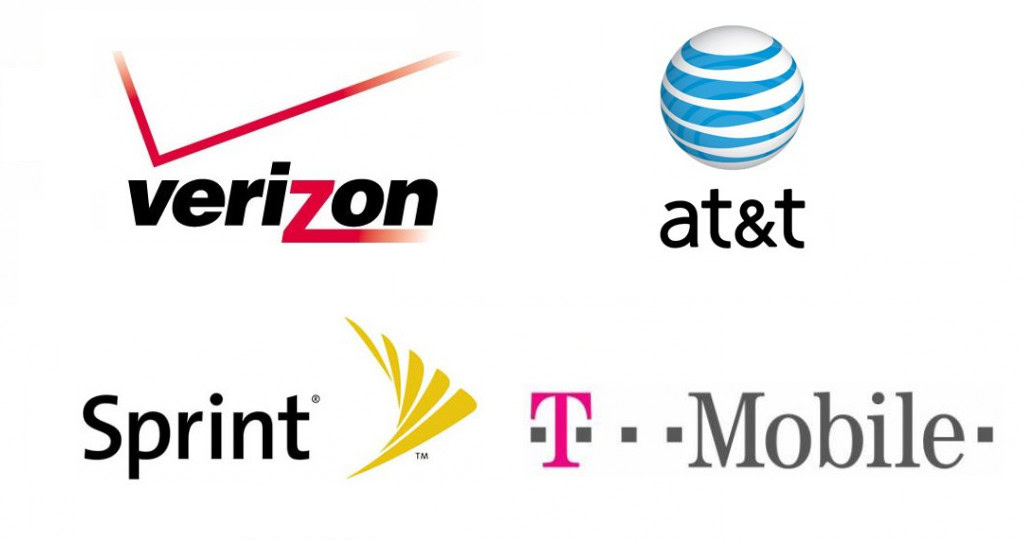
When it comes down to it, our main goal at Android Authority is to help readers to be as informed about mobile technology as possible. We’ve brought you news of wireless spectrum purchases and details regarding new service plans offered by the biggest American providers, among other noteworthy topics. But there’s been a key piece of the puzzle missing thus far, which is to distill and consolidate all this information into one concise resource. And that brings me to the important question that guided all the information you’ll find below: Which of the ‘Big Four’ wireless carriers is right for you?
Read Next: Best Internet providers in the US
Obviously, this is quite the loaded question, and I don’t presume to believe I can provide a definitive answer for everyone. Instead, what I’ve done is broken down the process of answering this rather large question into a series of smaller questions that, through the process of elimination, should help you to identify the wireless provider that would best suit your needs. So without further ado, let’s jump right into it.
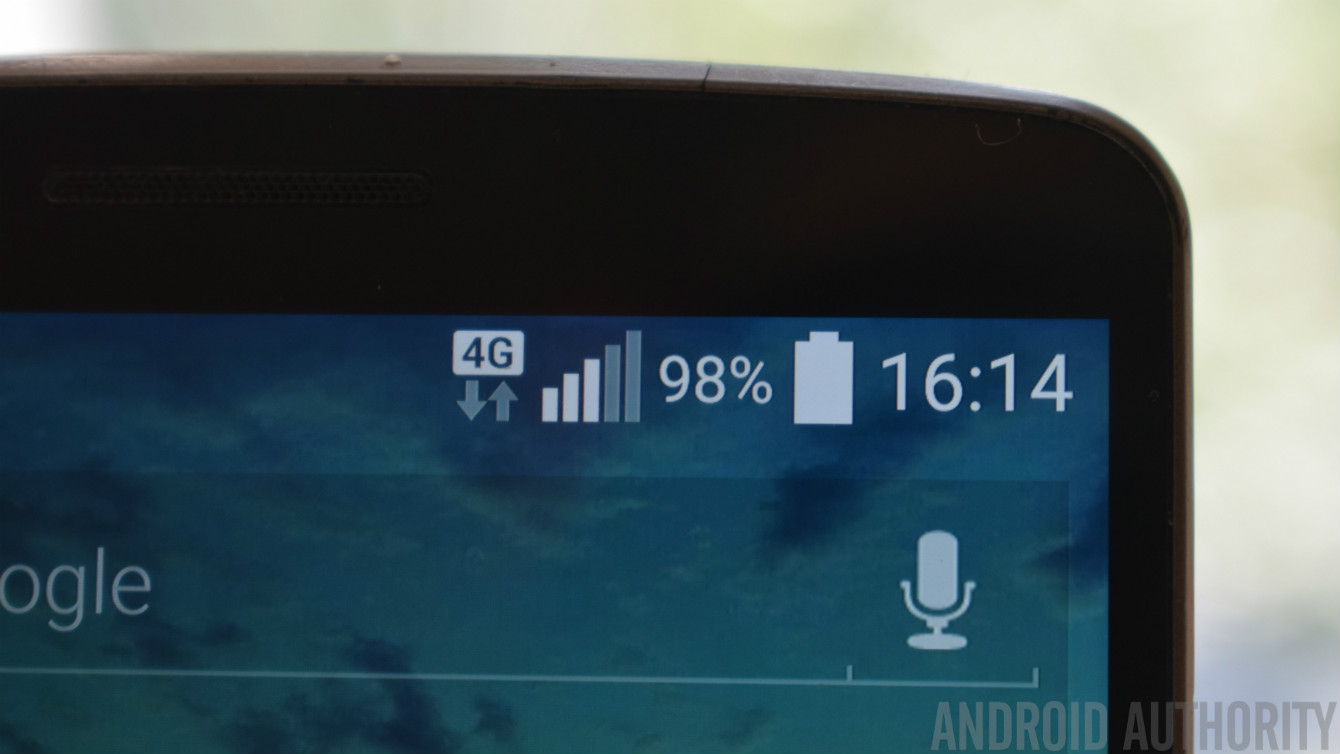
What are your coverage needs?
As I’m not one to shy away from a challenge, let’s start things off by diving into what’s surely the most important feature of a wireless provider: coverage. When it comes to picking a wireless provider, it’s definitely coverage that makes this a tricky decision, particularly because coverage is a much less straightforward metric than you might think.
The best way to gauge a provider’s coverage would be to trek across every square inch of the US, making test phone calls to see if “you can hear me now”. But as much as that may be the most reliable test of coverage, it’s not the most realistic method. Since we can’t do that, we have to rely on other metrics, and that brings up an entirely different problem, which is that most providers use vague language when it comes to defining and delineating their coverage areas.
When a company claims to have the best coverage, they’re not usually referring to how much of the US they cover. Instead, coverage typically refers to how many Americans fall within a provider’s service area.
When a company claims to have the best coverage, they’re not usually referring to how much of the US they cover; if that were the case, Sprint would come in dead last and have virtually no appeal to prospective subscribers. Instead, coverage typically refers to how many Americans fall within a provider’s service area. It’s such syntactical technicalities as this that allow providers to make claims of “99 percent US coverage” while enormous holes (particularly in Middle America) riddle their coverage maps or to claim that the competition’s coverage is “within one percent” of their own in terms of area or quality.
For what it’s worth, sources have shown that Verizon covers the largest number of Americans, followed closely by AT&T. If we take these coverage maps at face value, T-Mobile is a few paces behind AT&T with Sprint trailing distantly in last place. (You can take a look at and compare these maps on the RootMetrics website.) But raw coverage area alone doesn’t necessarily determine which provider is best for you because, among other reasons, there are inevitably going to be places one provider covers that another one doesn’t. Unless you live in an urban or suburban area that’s covered by all four carriers, the percentage of Americans covered by a provider isn’t all that telling, and it’s for this very reason that studies have started focusing more on quality rather than quantity of network. Don’t worry; we’ll get there.
As you determine which provider has the best coverage for your needs, there are two important questions you should ask yourself. First, is there coverage in the area or region in which you spend the majority of your time? In particular, your hometown and any surrounding areas in which you frequently venture. The second question has a few different parts: Do you travel? Are your trips confined to one specific area or do you occasionally head to parts unknown? The reason these questions are important is because (a) we obviously want coverage at our homes, particularly as landlines become increasingly antiquated, and (b) we’re likely want service in any places to which we may be traveling. At least when at these two junctures, we should have peace of mind.
There are two major points to consider with coverage: 1- is there coverage in the area or region in which you spend the majority of your time? 2- do you travel often to areas with different coverage?
If you want to be safe, you could choose the provider that offers the most impressive coverage map that includes your home and any areas to which you travel or plan to travel. Of course, most providers offer surcharge-free domestic roaming, so lack of coverage on a provider’s map doesn’t necessarily indicate a dead zone. In fact, so-called “dead zones” are what you want to be most wary of, making sure that you’ll encounter as few of them as possible in your day-to-day life.
Although there are some exceptions, any of the Big Four would suit someone who needs coverage in one of the larger cities in the US. Similarly, those who find themselves almost exclusively in metropolitan areas would likely be happy with any of them. It’s when you start to getting to smaller towns and communities that coverage becomes a bigger question, and it’s difficult to predict which of the Four would be best without historical data on which to base the prediction.
Again, since there are going to be places where some providers offer coverage and others don’t, choosing a wireless provider based only on coverage should be done on a case-by-case basis; however, it’s likely that coverage isn’t the only thing you need from a wireless provider. It may not even be the most important thing, which brings us to the second stop on our journey…
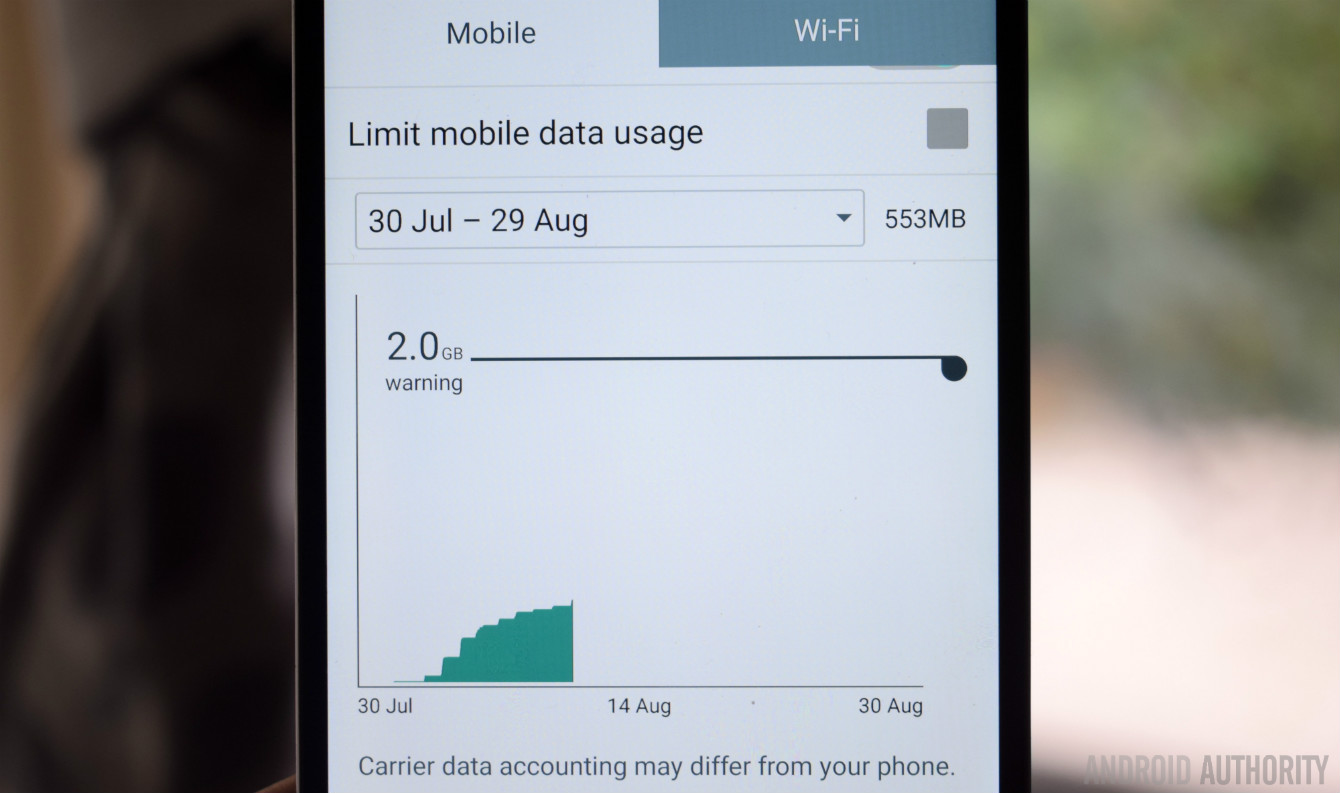
Do you use a lot of mobile data?
With coverage out of the way, we can get into some qualifiers that are a bit more cut-and-dry, like data performance. There’s a good chance that you use your mobile device for internet access far more often than you use it as an actual phone. In fact, the point at which we began using mobile phones for data more than for actual phone calls was documented in 2010, so we can safely assume that, if anything, that’s even moreso the case today. For this reason, data performance is surely among users’ most important features in a wireless service provider.
In August 2017, OpenSignal released its latest “State of Mobile Networks: USA” report, which analyzed crowdsourced data consisting of 5 million data points from some 172,000 mobile devices on the Verizon, Sprint, T-Mobile, and AT&T networks. A major focus of OpenSignal’s study was data performance, and the results found that the prevalence of unlimited data is taking its toll on some network speeds.
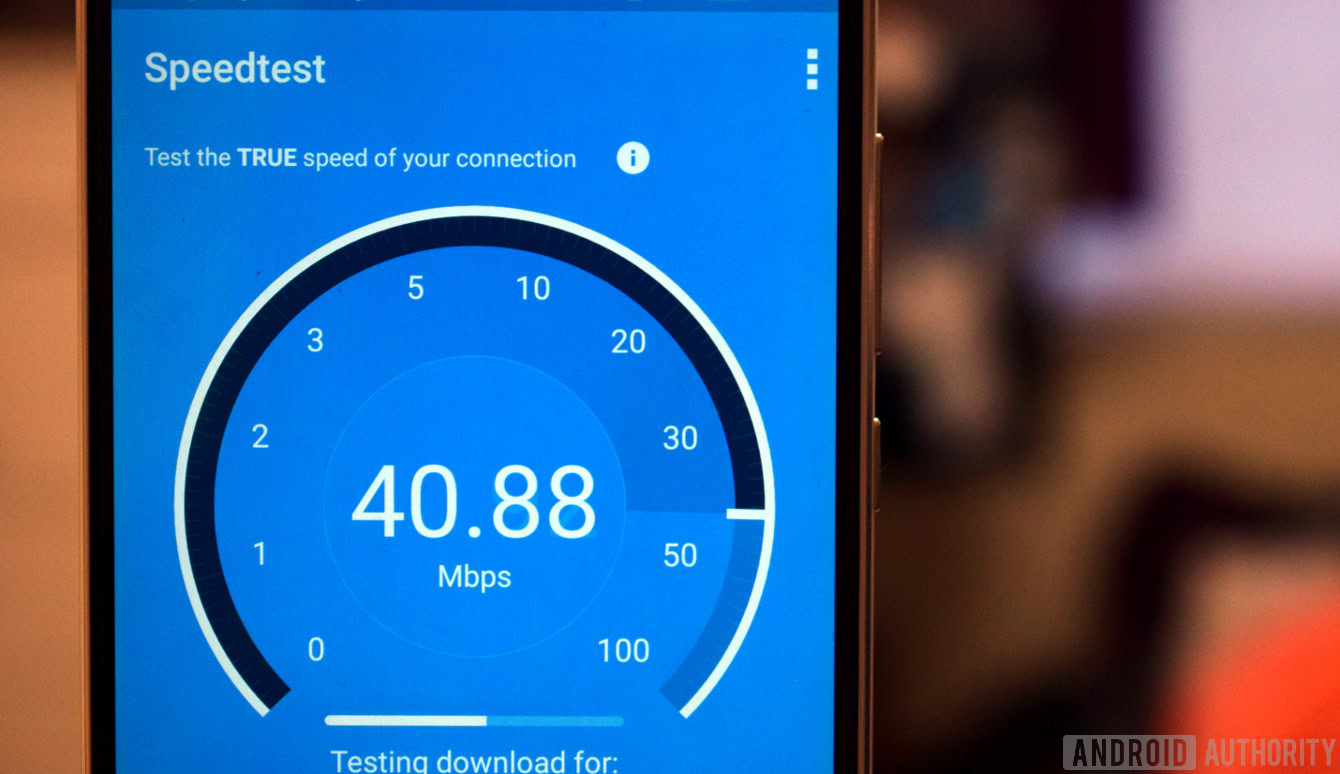
According to OpenSignal’s study, T-Mobile and Verizon have the best LTE availability with roughly 90 percent of subscribers able to access LTE data speeds at any given time. These two are followed by AT&T and Sprint at 83 percent and 82 percent, respectively. Meanwhile, Verizon and T-Mobile were found to offer the best download speeds, but it’s now T-Mobile that takes the lead with 17.5 Mbps typical compared with Verizon’s 14.9 Mbps. The reason for Verizon’s slower performance of late is assumed to be the result of more users enjoying unlimited data, thereby taking up network capacity.
AT&T, however, isn’t too terribly far behind with download speeds averaging just a little under 13 Mbps, which, in turn, is substantially faster than Sprint’s average of 9.8 Mbps. The numbers also indicate that Sprint has a bigger ratio of subscribers who can only access sub-LTE data speeds, which is why the company’s average data speed is just half that of Big Red and Magenta. With coverage maps indicating the second-best coverage by volume, AT&T consistently gets middle-of-the-road rankings for LTE availability and speed.
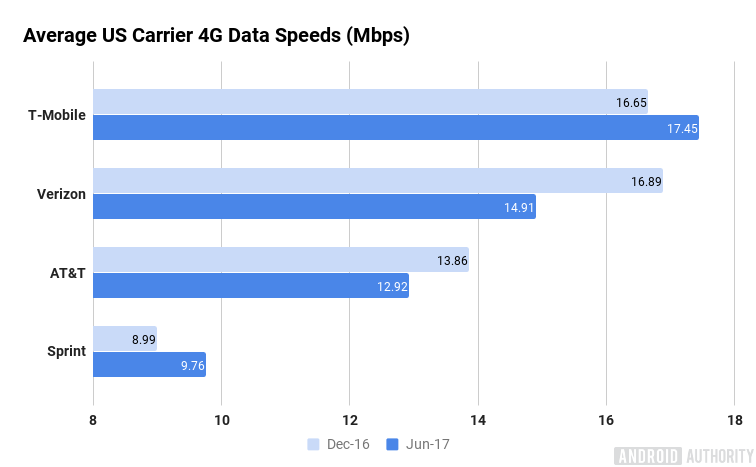
Earlier this year, Verizon, AT&T, and T-Mobile committed to rolling out gigabit data speeds on their respective networks by the end of 2017, which will surely be achieved via LTE-A. LTE-A — or LTE “Advanced” — has been making its way to the US after being available in Europe and Asia for a while. At this point, all four carriers have implemented the technology to some degree. AT&T has been rolling out LTE-A for the past few years, Sprint’s version called Spark began rolling out in late 2014, and there are currently several hundreds of cities covered by Verizon’s version of the enhanced technology. Although a bit late to the game, T-Mobile has started to roll out LTE-U (which is part of the LTE-A standard) in six cities. Fortunately, the number of devices capable of taking advantage of these enhanced speeds has grown, making LTE-A more of a selling point than it previously was.
Even though Verizon has an impressive LTE network, Big Red is no longer the only compelling option when it comes to data performance. Recently, T-Mobile has made big moves for coverage and speed in the US, and the “Uncarrier’s” network is about to get a boost as T-Mobile deploys its new nationwide 600 Mhz spectrum after securing 45 percent of the spectrum at auction earlier this year. This low-band spectrum will offer better speeds and better performance indoors while significantly extending range (although a new device will be needed to take advantage of these gains). However, until then, Sprint is the most-improved network for 2017, according to OpenSignal, due to having improved its LTE reliability and speeds over the past year.
Without a doubt, the best carriers for data are Verizon and T-Mobile. In OpenSignal’s regional performance comparison, either Verizon or T-Mobile offered the best data performance in the majority of regions, and in some cases, the providers were tied. Out of 36 regions, T-Mobile and Verizon were ranked as top-performing wireless networks in all but a single region. If you’re someone who uses a lot of data or for whom data performance is among the top criteria for a wireless provider, you couldn’t go wrong with either Verizon or T-Mobile.
What kind of plan do you need?
When wireless providers did away with two-year contracts by putting an end to subsidized phones, we were told that the cost of our service would decrease. I don’t know about you, but I personally didn’t see my bill go down. To make matters worse, carriers tried to do away with unlimited data plans, causing many of us to get slammed with overages. Fortunately, unlimited data plans have been making a comeback this year, but finding the best deal often requires a little homework and sifting through a lot of fine print.
Fine print notwithstanding, plans are arguably the most straightforward part of a wireless provider. To choose the provider with the plan that’s right for you, you need only to ask yourself a few key questions, such as:
- Will I need a “family plan” or just a single line?
- Do I use a lot of data?
- Do I or will I travel abroad?
- Do I have the need for add-on features (i.e, tethering, insurance, etc.)?
- What is my budget or desired price range?
Determining if you’ll need a family plan should be easy since you should already know whether your own phone line will be the only line on your account or if you’ll be needing additional lines for a spouse, parent, teen, or somebody else. With unlimited plans being the latest trend, you might consider simply going unlimited if you’re anything but the most casual data user. And while spontaneous trips can sometimes occur, it’s likely that you’ll know whether there are any international trips in your immediate future.
With many providers consolidating things like minutes, text messages, and data into bundles, it’s often the add-on services and features that have the most potential to increase the cost of your plan. In the not-too-distant past, tethering — connecting a device to your smartphone so as to use your smartphone’s mobile data — would be one of those additional costs. Another example would be those equipment protector and insurance plans that most carriers offer. Most carriers offer at least a handful of different add-ons.
(Note: Keep in mind that most of the prices listed on each provider’s website are adjusted to account for an autopay discount. More often than not, the final amount for a plan could be $5 more for a single line or $10 more for multiple lines.)
With T-Mobile, streaming video is capped at 480p quality unless you upgrade to a premium ONE plan.
T-Mobile’s unlimited plans — called T-Mobile ONE — are often cited as being what pushed the other carriers to offer more competitive unlimited plans. Beginning at $75 per month, T-Mobile ONE includes unlimited talk, messaging, and data, but there are certain stipulations. For instance, those who are among the top 3 percent of data users — who use an estimated 32 GB of data per month or more — will be “deprioritized”, which essentially means a decrease in data speed and performance. As well, streaming video is capped at 480p quality unless you upgrade to a premium ONE plan. There are also limitations regarding tethering.
However, you have the option to upgrade the ONE plan to ONE Plus by adding an addition $10 per month, which removes many of the stipulations and adds certain premium features like unlimited in-flight data for domestic flights offering GoGo service. It’s also worth noting that all of T-Mobile’s ONE plans have taxes and fees included in the plan price and will cost $5 less per month if you sign up for autopay (most of the prices shown on the T-Mobile website reflect this autopay credit).
| T-Mobile Plans | ONE | ONE Plus |
|---|---|---|
| T-Mobile Plans 1 Line | ONE $75 ($70 w. autopay) | ONE Plus $85 ($80 w. autopay) |
| T-Mobile Plans 2 Lines | ONE $110 ($105 w. autopay) | ONE Plus $120 ($115 w. autopay) |
| T-Mobile Plans 3 Lines | ONE $155 ($150 w. autopay) | ONE Plus $165 ($160 w. autopay) |
| T-Mobile Plans 4 Lines | ONE $180 ($175 w. autopay) | ONE Plus $190 ($185 w. autopay) |
For multiple lines, the same ONE plans apply, but the rates change with each additional line. If you needed two lines on your account, a base ONE plan would cost $100, or $50 per line. For four lines on a basic ONE plan, the cost would be $40 per line, or $160 total.
Sprint has not been one to shy away from unlimited data plans. The company offers a base plan that begins at $60 per month for a single line, $100 per month for two lines, and $30 additional for each line after the second. The features of the base plan are comparable to T-Mobile’s ONE plan, but without certain restrictions like the 480p quality cap for streaming video. Notably, Spring often has promotions on its plans (as is the case currently), which usually amounts to knocking ten dollars of each line.
| Sprint Plans | 2GB | Unlimited |
|---|---|---|
| Sprint Plans 1 Line | 2GB $45 ($40 w. autopay) | Unlimited $65 ($60 w. autopay) |
| Sprint Plans 2 Lines | 2GB $90 ($80 w. autopay) | Unlimited $110 ($100 w. autopay) |
| Sprint Plans 3 Lines | 2GB $135 ($120 w. autopay) | Unlimited $145 ($130 w. autopay) |
| Sprint Plans 4 Lines | 2GB $180 ($160 w. autopay) | Unlimited $180 ($160 w. autopay) |
Due to AT&T’s acquisitions of DIRECTV and Warner Bros., many of AT&T’s plans include television services, including the relatively new DIRECTV streaming service and HBO GO. With streaming video requiring a ton of data, it makes sense that AT&T would bundle in-house streaming services into its bundled unlimited plans, and if you happen to be in the market for a streaming television service that will allow you to cut the cord, they’re pretty compelling plans.
The base unlimited plan is the AT&T Unlimited Choice plan at $65 (although it becomes $60 if you sign up for autopay). As you’d expect, Unlimited Choice has many of the same stipulations as the base T-Mobile ONE plan; however, this entry-level unlimited plan actually limits data speeds to 3 Mbps. If you want full-speed data as well as 10 GB of high-speed tethering and high-quality streaming video, you’d want Unlimited Choice Plus at $95. The Plus plan also includes the HBO streaming service. It’s worth noting, too, that both plans can accommodate multiple lines; the cost for a single line is applied to the second line, but with a five-dollar discount. After the second line, lines three and above cost $20 each.
Unlimited plans aren’t the only option AT&T offers. Until recently, unlimited data was available only to AT&T customers who also had DIRECTV, leaving everyone else with only the “data bucket” plans to choose from, which are still available today. Basically, you pay for a set amount of data — 1 GB for $30, 3 GB for $40, 6 GB for $60, etc. — with a line-access fee of $20 on top. With the line access fee, you get unlimited voice and messaging. So if you chose the 1 GB data option, your plan would cost just $50 ($20 line access + $30 for 1 GB of data), not including taxes and fees. If your data needs are small, this could be a great way to save some money on AT&T service.
| AT&T Plans | 1 GB | 3 GB | 6 GB | Unlimited Choice | Unlimited Plus |
|---|---|---|---|---|---|
| AT&T Plans 1 Line | 1 GB $55 ($50 w. autopay) | 3 GB $65 ($60 w. autopay) | 6 GB $80 ($75 w. autopay) | Unlimited Choice $65 ($60 w. autopay0 | Unlimited Plus $95 ($90 w. autopay) |
| AT&T Plans 2 Lines | 1 GB $80 ($70 w. autopay) | 3 GB $90 ($80 w. autopay) | 6 GB $100 ($90 w. autopay) | Unlimited Choice $125 ($115 w. autopay) | Unlimited Plus $155 ($145 w. autopay) |
| AT&T Plans 3 Lines | 1 GB $100 ($90 w. autopay) | 3 GB $110 ($100 w. autopay) | 6 GB $120 ($110 w. autopay) | Unlimited Choice $145 ($135 w. autopay) | Unlimited Plus $175 ($165 w. autopay) |
| AT&T Plans 4 Lines | 1 GB $120 ($110 w. autopay) | 3 GB $130 ($120 w. autopay) | 6 GB $140 ($130 w. autopay) | Unlimited Choice $165 ($155 w. autopay) | Unlimited Plus $195 ($185 w. autopay) |
Now we get to Verizon. Historically an anti-unlimited carrier with a reputation for costly plans, Verizon recently introduced unlimited data plans at reasonable prices, making the company much more competitive with the likes of T-Mobile and Sprint. And while some carriers’ plans can be kind of confusing with all the stipulations and limitations, Verizon’s plans have been simplified and exist at four levels: Small, Medium, Large, and Unlimited. The Small plan includes unlimited talk, text, and 2 GB of high-speed data for $60 before the autopay credit. At the Medium and Large levels, you’ll get 4 GB and 8 GB of data for $75 and $95, respectively. Last but not least, Verizon’s unlimited plan costs $85.
Perhaps the greatest benefit of Verizon’s plans is that there aren’t the stipulations that the other carriers tack onto their so-called unlimited plans
These plans can be adapted for families, too. The cost of the tiered plans are calculated by taking a base cost for the data and adding line access fees for each line. So for the mid-level plan, you start with a base of $55 for 4 GB of data per line, then add $20 for each line; if you were bringing three lines to Verizon, this plan would cost $95 per month before taxes, fees, and any autopay discounts. For the unlimited plan, a single line costs $85 before the autopay discount, two lines cost $150, three lines cost $170, four lines cost $190, and so on.
Perhaps the greatest benefit of Verizon’s plans is that there aren’t the stipulations that the other carriers tack onto their so-called unlimited plans; for instance, Verizon’s plans don’t put a limit to the quality of your streaming video, they don’t cap your data speeds, and they don’t limit tethering.
| Verizon Plans | 2 GB (S) | 4 GB (M) | 8 GB (L) | Unlimited |
|---|---|---|---|---|
| Verizon Plans 1 Line | 2 GB (S) $55 | 4 GB (M) $70 | 8 GB (L) $90 | Unlimited $85 ($80 w. autopay) |
| Verizon Plans 2 Lines | 2 GB (S) $75 | 4 GB (M) $90 | 8 GB (L) $110 | Unlimited $150 ($140 w. autopay) |
| Verizon Plans 3 Lines | 2 GB (S) $95 | 4 GB (M) $110 | 8 GB (L) $130 | Unlimited $170 ($160 w. autopay) |
| Verizon Plans 4 Lines | 2 GB (S) $115 | 4 GB (M) $130 | 8 GB (L) $150 | Unlimited $190 ($180 w. autopay) |
Assuming that you’ve narrowed down the carrier options to the ones that perform the best in the areas you need, looking at their plans is a great next step to narrowing them down to the one that’s best for you. If Verizon and Sprint are neck-and-neck in terms of network quality for your area, you might be able to choose between them by determining which could offer you the best plan at the lowest rate.
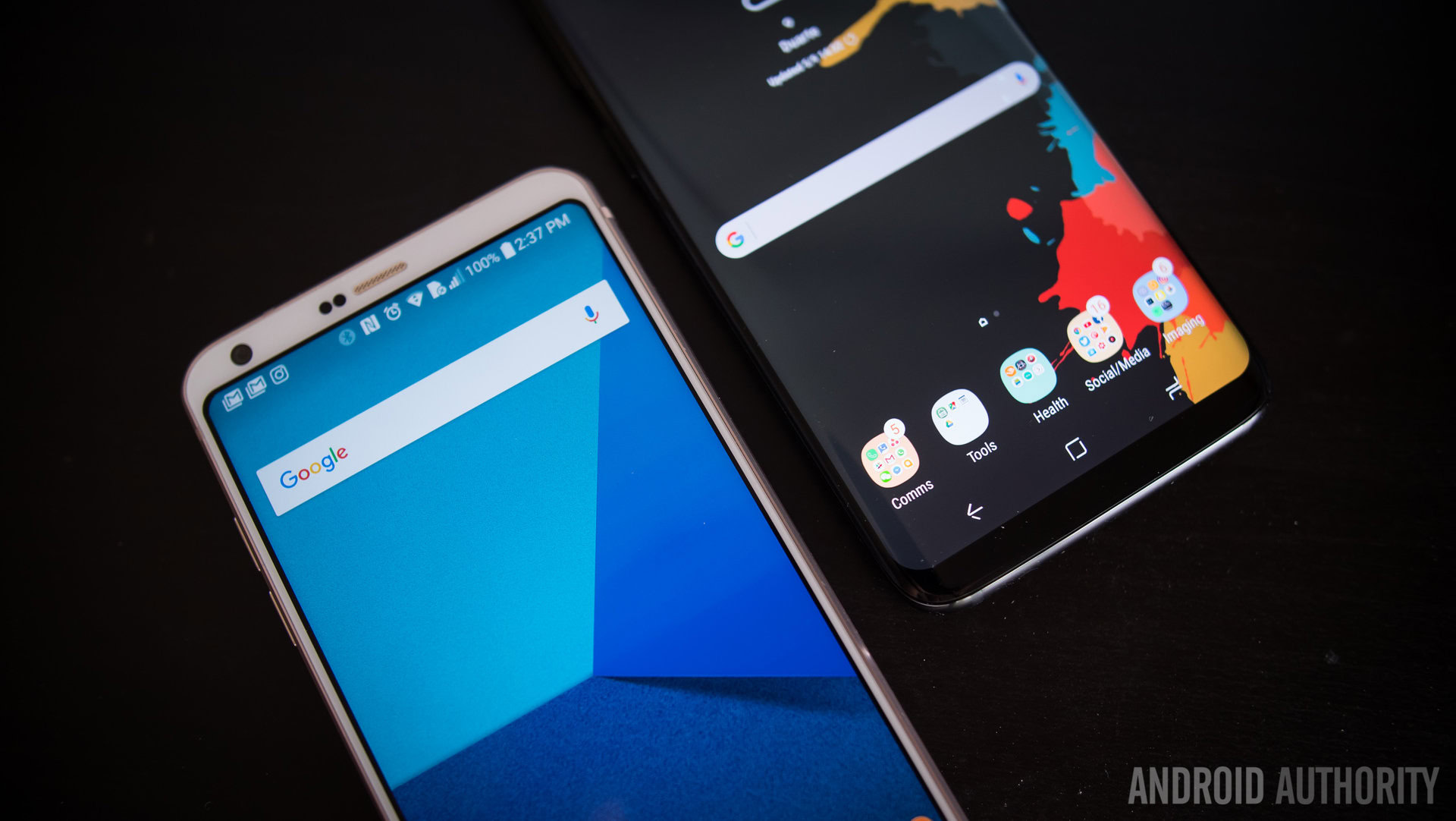
Will you buy your handset from your provider?
Unless you’re the type who never appreciated being coerced into two-year contracts by the prospect of discounted phones, you were probably disappointed when the Big Four did away with subsidized phones. Although it (mostly) gave us the ability to jump between networks as we pleased, it essentially forces us to pay the full retail cost of increasingly expensive devices. In fact, certain upcoming flagships could cross the thousand-dollar threshold, making it harder than ever to keep ourselves in the freshest tech.
As you choose a wireless provider, another consideration is what options they offer for you to get a new phone. In the two-year-contract era, we would get a subsidized phone, use it for 24 billing cycles, and renew our contracts to get new phones as a discount. Unfortunately, no matter how long we wait between upgrades, subsidized phones are a thing of the past, which leaves us with three options: financing, leasing, and buying outright.
Obviously, the third choice entails having to spend hundreds and hundreds of your hard-earned dollars in one fell swoop. Not ideal. The other two options — financing and leasing — might make your wallet happier today but have their own drawbacks.
Each of the Big Four offers financing that works basically like this: Cost of device ÷ 24 months = payment added to monthly bill. Sometimes with an upfront cost.
Financing your device basically means that the full retail cost of your chosen phone is dividing into 24 installments and added to your monthly bills, allowing you to pay for new devices gradually instead of all at once. But going this route is essentially like signing a two-year contract since the remaining balance of your device becomes due in the event that you were to cancel your service; in other words, financing a phone is a lot like signing a two-year contract without the discount. Even so, financing will still be the best option for most people with the operative word being “most”.
Since the carrier is essentially handling you a phone in exchange for your promise to pay for it later, financing a device requires “creditworthiness”, also known as a credit check. If you have good credit, you have nothing to worry about, but for youngsters who don’t have established credit or those with somewhat checkered credit histories, financing might not be an option. For those with poor creditworthiness, an upfront payment for part of the cost of the device might be required, or it’s possible that paying full retail for the phone would be the only option.
Just like financing, leasing a device also requires creditworthiness, but the difference is that you’re making monthly payments to rent a device rather than to own it. It’s very similar to leasing a car in that you make payments to rent the phone for a predetermined amount of time, at which point you become eligible to trade in the phone for something new and the process begins again. Leasing is a good option for someone who would prefer being able to frequently get new devices, but the caveat is that there’s no return on investment since the payments you’ve made don’t count toward anything.
Each of the Big Four offers financing that works basically as described above: Cost of device ÷ 24 months = payment added to monthly bill. The exception to this formula would be when there’s an upfront payment required. The reason for upfront payments is to ensure that the monthly payments for a device stay below a certain threshold, which is usually about $35. Then there are the leasing programs that most of them have.
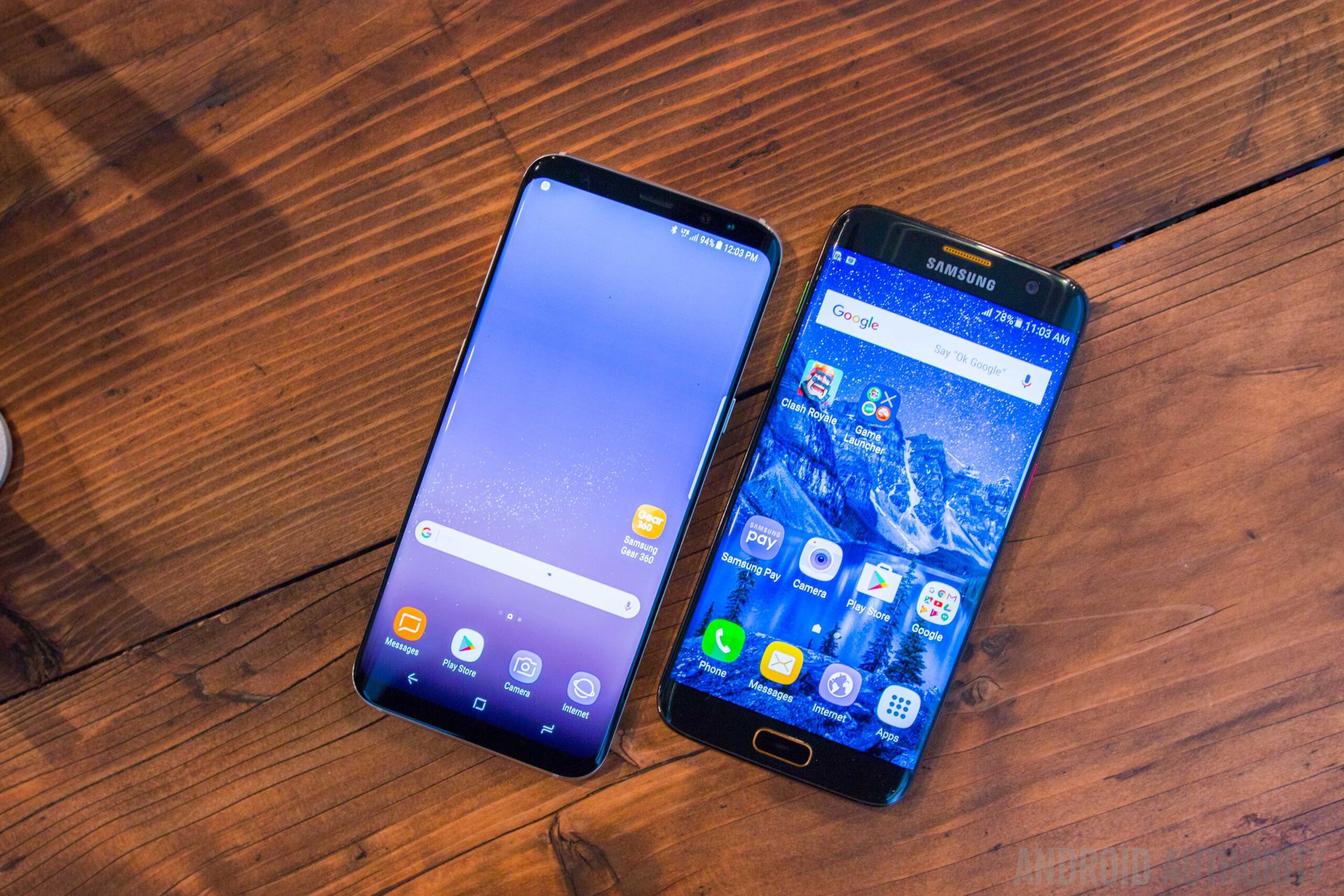
AT&T has two leasing program options called Next and Next Every Year. The former allows you to lease at device and trade it in after two years at long as 80 percent of the device’s retail price has been covered by payments. Next Every Year is similar, but it allows you to trade in your device every 12 months, or once each year.
At T-Mobile, the leasing programs are JUMP! and JUMP! On Demand. The former works by allowing you to trade in your device for something new once half the retail cost of your phone has been covered by your monthly payments. The cost for JUMP! is an additional $15 added to the cost of your plan and the device you’re leasing. Although JUMP! On Demand works similarly, instead of paying for both JUMP! and device payments you pay a set amount each month, allowing you to trade in your device up to three times in a 12-month period. The amount you pay per month is determined by your creditworthiness.
Unfortunately, Verizon doesn’t really offer a leasing program anymore. Currently, the only option is to buy a device either outright or to pay via monthly installments.
Sprint’s leasing program is called Flex and it’s arguably the most straightforward of the bunch. Like T-Mobile’s JUMP! Program, Flex is an additional fee you pay each month alongside the monthly payment for the device. When you choose your desired device, the cost of that device is broken into 18 installments that are added to your monthly bill. Once you’ve made 12 payments on the device, you’re eligible to trade it in for another, or you can pay the 6 remaining payments to own the device.
Generally, there are no game-changing differences between the Big Four when it comes to buying or leasing devices. Similarly, we can expect them all to offer virtually the same flagship smartphones as well as a plethora of lower- and mid-range smartphones. Of course, there are occasionally noteworthy devices that end up being carrier-exclusive. For instance, T-Mobile used to be practically synonymous with the SideKick, AT&T was the only carrier to offer the iPhone for a while, and Verizon had an exclusive on last year’s Google Pixel phones last year, so it’s always a possibility that the next phone you can’t wait to get your hands on is only on one network.
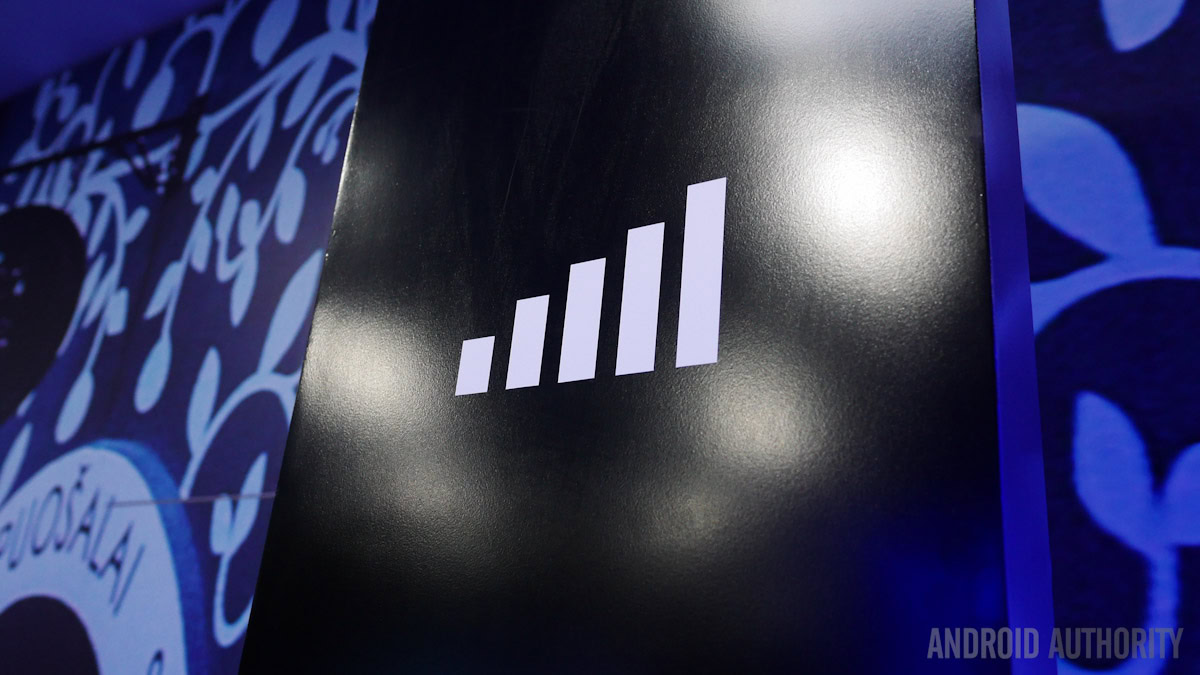
Conclusion
Over the course of this article, we discussed wireless coverage, compared data performance, reviewed the features and costs of service plans, and examined financing and leasing options that the carriers offer. For most consumers, these are deciding factors when it comes to choosing a wireless provider.
Chances are good that you already have some idea of which carriers perform the best in your area, either due to having experienced their coverage firsthand or having had friends or family members on those networks. However, if you’re curious about testing out a network you’ve never used before, you might consider buying a SIM card for one of the MVNOs (Mobile Virtual Network Operators) that lease that network’s tower; for example, prepaid services like Boost Mobile and Cricket can provide a commitment-free snapshot of what service is like when you’re on Sprint’s or AT&T’s network, respectively. Most carriers are now offering their own in-house prepaid service, too. If you happen to live somewhere with spotty coverage, some MVNOs operate on more than one carrier’s network, which might actually close some of the coverage gaps.
| AT&T | Sprint | T-Mobile | Verizon | |
|---|---|---|---|---|
| AT&T Cricket | Sprint Boost Mobile | T-Mobile MetroPCS | Verizon C-Spire | |
| AT&T H2O Wireless | Sprint Project Fi | T-Mobile Project Fi | Verizon Rok Mobile | |
| AT&T StraightTalk | Sprint Virgin Mobile | T-Mobile Simple Mobile | Verizon Total Wireless |
With contracts being essentially nonexistent, you can actually join any of the Big Four for a test run; simply use your own device and purchase a SIM card with which to start a new plan. If you’d happen to need a device, most providers offer a risk-free trial period — usually 15 or 30 days — after which you can return your device and cancel service without penalty. Obviously, actually using the service is going to be the absolute best way to find out just how well (or poorly) it will work for you.
Now I’d like to hear from you. Which carrier do you use currently? Are you happy with your provider or are you considering one of the other Big Four? Do you have any advice for others who might be shopping for a wireless service? Sound off in the comments below.